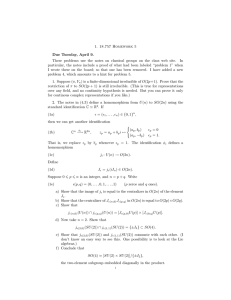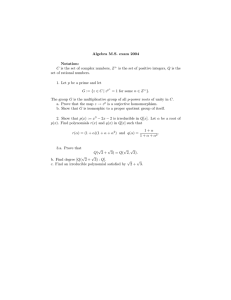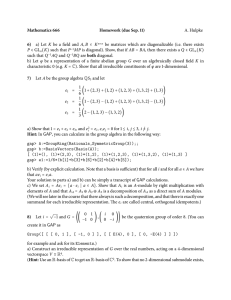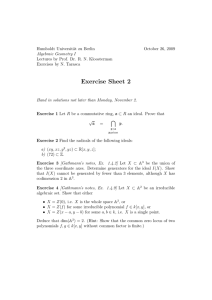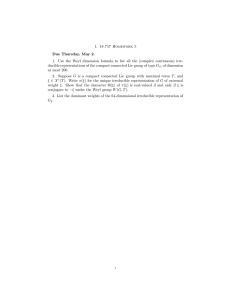Mathematics 666 Homework (due Oct. 16) A. Hulpke Let
advertisement
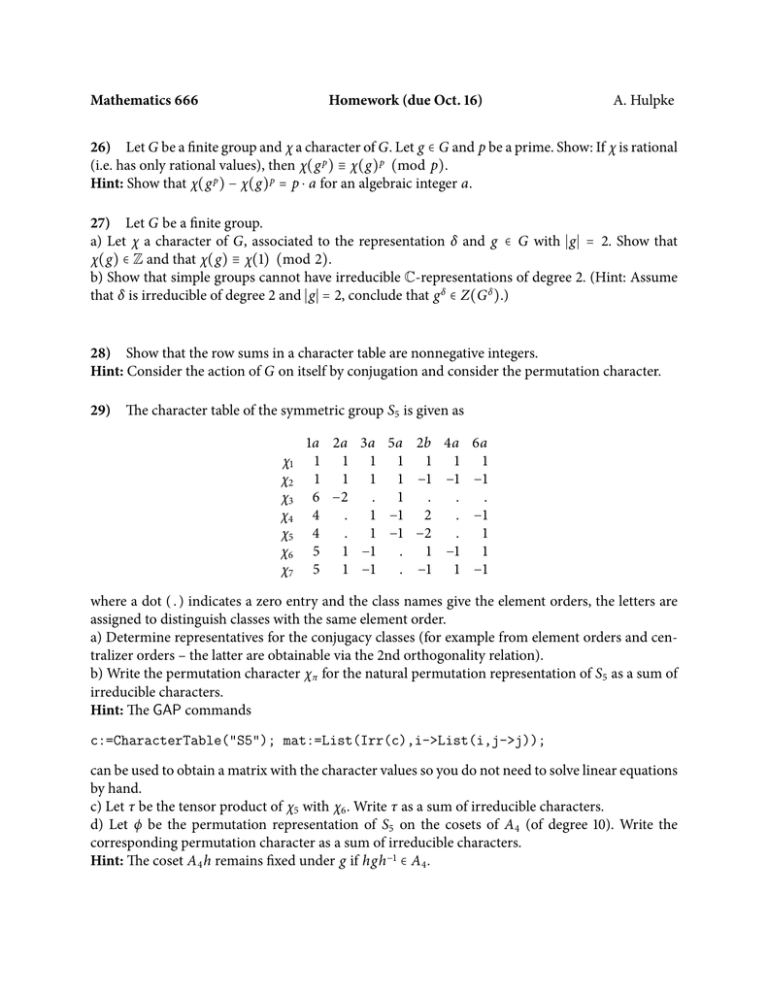
Mathematics 666 Homework (due Oct. 16) A. Hulpke 26) Let G be a finite group and χ a character of G. Let g ∈ G and p be a prime. Show: If χ is rational (i.e. has only rational values), then χ(g p ) ≡ χ(g) p (mod p). Hint: Show that χ(g p ) − χ(g) p = p ⋅ a for an algebraic integer a. 27) Let G be a finite group. a) Let χ a character of G, associated to the representation δ and g ∈ G with ∣g∣ = 2. Show that χ(g) ∈ Z and that χ(g) ≡ χ(1) (mod 2). b) Show that simple groups cannot have irreducible C-representations of degree 2. (Hint: Assume that δ is irreducible of degree 2 and ∣g∣ = 2, conclude that g δ ∈ Z(G δ ).) 28) Show that the row sums in a character table are nonnegative integers. Hint: Consider the action of G on itself by conjugation and consider the permutation character. 29) The character table of the symmetric group S5 is given as χ1 χ2 χ3 χ4 χ5 χ6 χ7 1a 2a 3a 5a 2b 4a 6a 1 1 1 1 1 1 1 1 1 1 1 −1 −1 −1 6 −2 . 1 . . . 4 . 1 −1 2 . −1 4 . 1 −1 −2 . 1 5 1 −1 . 1 −1 1 5 1 −1 . −1 1 −1 where a dot (.) indicates a zero entry and the class names give the element orders, the letters are assigned to distinguish classes with the same element order. a) Determine representatives for the conjugacy classes (for example from element orders and centralizer orders – the latter are obtainable via the 2nd orthogonality relation). b) Write the permutation character χ π for the natural permutation representation of S5 as a sum of irreducible characters. Hint: The GAP commands c:=CharacterTable("S5"); mat:=List(Irr(c),i->List(i,j->j)); can be used to obtain a matrix with the character values so you do not need to solve linear equations by hand. c) Let τ be the tensor product of χ5 with χ6 . Write τ as a sum of irreducible characters. d) Let ϕ be the permutation representation of S5 on the cosets of A4 (of degree 10). Write the corresponding permutation character as a sum of irreducible characters. Hint: The coset A4 h remains fixed under g if hgh −1 ∈ A4 . As the GAP command RightTransversal can be used to obtain a set of representatives for the cosets, the following command thus determines representatives of those cosets, which remain fixed under the group element g: Filtered(RightTransversal(s5,a4),h->h*g/h in a4); 30) (Followup on 17) Let G = GL3 (2). (This is up to isomorphism the only simple group of order 168.) We want to determine the character table of G. The following steps indicate one possible way, but you may try other methods: a) Determine class sizes and centralizer orders. (First determine lower approximations for the centralizer orders from centralizing elements you can find easily, then show by a counting argument that the corresponding class sizes sum up to the group order, and the centralizers thus cannot be larger.) You can use GAP to verify your results by calling: g:=GL(3,2); cl:=ConjugacyClasses(g); List(cl,i->Order(Representative(i))); # orders of class representatives Display(Representative(cl[3])); # matrix form of a class representative List(cl,Size); # cardinalities of classes List(cl,i->Size(Centralizer(i))); # cardinalities of centralizers b) Determine the permutation character for the permutation action of G on the seven nonzero vectors in F2 3 . Show that its nontrivial part is irreducible. c) Determine the 2-powermap for G (i.e. the map that for each conjugacy class g G indicates the class of squares (g 2 )G ). (Hint: The 3rd power of elements of order 7 is in the other class of order 7, thus the 2nd powers are in the same class.) Using the formula from exercise 29 (or using GAP) determine symmetric parts of tensor products. Reduce these with the known irreducible characters. Iterate until no new irreducible characters have been found. d) At this point you will be missing two irreducible characters. What are their possible degrees? What is their sum? Show that by problem 28 we can deduce that one must be a Galois conjugate of the other. Then use the orthogonality relations to determine the remaining character values.
